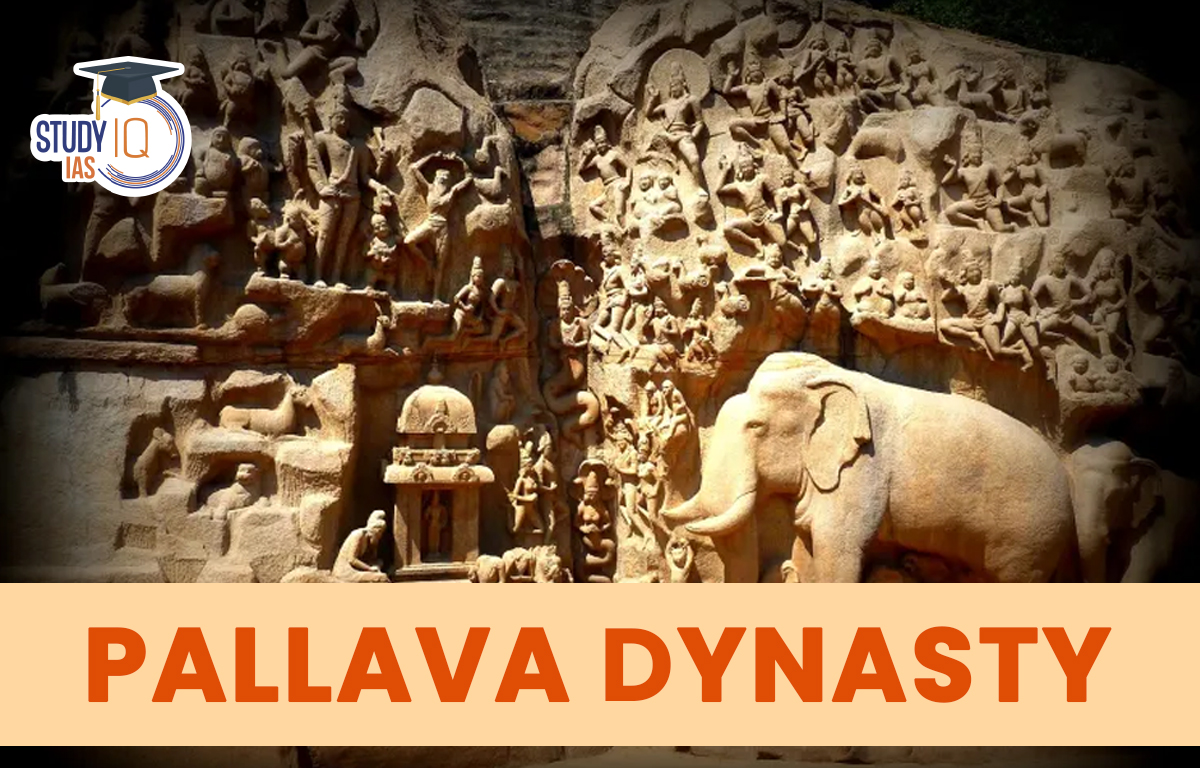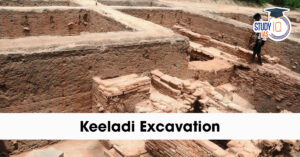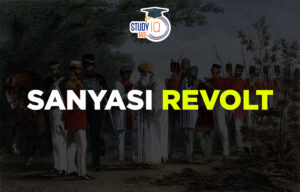Table of Contents
Pallava Dynasty
Pallava Dynasty was situated on the territory of South India. The rule of the Pallavas Dynasty lasted from 275 to 897 CE. They added significantly to the areas of religion, philosophy, art, coins, and architecture and were the most powerful rulers in South India. Mahendravarman I and Narasimhavarman I was the apex of the Pallavas’ power. Throughout their reign in Tondaimandalam, they were at odds with the Tamil kingdoms of the Cholas and Pandyas in the south and the Chalukyas of Badami in the north. Their shore temple design is what is most recalled about them. In this article, we will discuss the Pallava Dynasty (275CE-897CE) as an important part of the History segment of the UPSC Syllabus.
Read More: South Indian Dynasties
Pallava Dynasty History
The history of the Pallavas is obscure. Numerous ideas have been put forth by historians. They are a branch of the Parthian people, an Iranian tribe that moved gradually to South India, claim some historians. Some people assert that they are an indigenous dynasty that originated in the South and was a fusion of different clans.
According to some experts, they originated from the Tondaimandalam area near Madras and were first settled there. Another hypothesis states that they are the children of a Manipallavam-born Naga princess and a Chola prince (Sri Lanka). Some people think that the Satavahanas had a dispute with the Pallavas. In the early fourth century AD, the first Pallava kings reigned. The Chalukyas of Badami, the Pandyas of Madurai, and the Pallavas of Kanchipuram fought it out for control of southern India by the seventh century AD.
Read More: Harshavardhana Dynasty
Pallava Dynasty Founder
The founder of the Pallava Dynasty is thought to be Simha Vishnu. He was a successful conqueror and commander who established Kanchi, also known as Kanchipuram, as his capital. He was also well-known as Avanisimha, Simhavarman III’s son and one of India’s most illustrious Pallava rulers. He ruled from 556 to 590 CE.
Pallava Dynasty Extent
Kanchipuram served as the Pallavas’ main city. When they were at their most powerful, their realms stretched from Andhra Pradesh’s northern region to the southern River Kaveri. The Pallavas’ power allowed the Cholas to be relegated to a minor power during the seventh century. The Pallava monarch Narasimhavarman, who overthrew the Chalukyas, occupied Vatapi (Badami).
The Pandyas, Chalukyas, and Pallavas all worked together to put an end to the Kalabhra rebellion. The Kalabhras were protesting the countless land grants (Brahamadeya) made by the Brahmanic rulers to Brahmanas.
Pallava Dynasty Map
Below given is the map representation of the Pallava Dynasty. Go through the map to know about the location of the Pallava Dynasty:
Pallava Dynasty Rulers
Sivaskanda Varman (4th Century AD)
Of the early kings, he was the most potent. It started in the fourth century AD as the ruler. The charter was given in 283 CE by Sivaskandavarman of Kanchi, a Pallava king who ruled from 275 to 300 CE. He offered Ashwamedha and other Vedic offerings.
Simhavarman/Simhavishnu (575-600 AD)
The first king of the dynasty was Simhavishnu. The “Age of the Imperial Pallavas” began when Simhavishnu vanquished the Kalabhras. He also overthrew the kings of the Chola, Pandya, and Chera countries. Between the Krishna and Kaveri rivers, he held absolute power over the entire area. He had the name Avanishimha and worshipped Vishnu (lion of the earth). Tradition has it that the great poet Bharavi visited him at his palace.
Mahendravarman (600-630 AD)
Simhavishnu’s son Mahendravarman I followed him. He was a polymath with many skills. He was a politician, a soldier, a poet, an architect, a musician, and a religious reformer. In addition to Mattavilasa, he also held the titles of Chitrakarapuli, Vichitrachitta, Gundabhara, and Lalitankura. The long-running Pallava-Chalukya dispute started during this period.
Near Kanchi, Pulakesin II defeated Mahendravarman I in the Pullalur fight. Pulakesin II was close to reaching the Pallava capital when Mahendravarman purchased peace by giving him control of their Northern provinces.
Narasimhavarman I (630-668 AD)
The authority and prestige of the Pallava dynasty reached incredible heights under Narasimhavarman I, the greatest of the Pallavas. His name, Mahamalla or Mamalla, is Arabic for “great fighter.” His father began the Pallava-Chalukya war, which he effectively carried on. He wanted to exact revenge on Pulakesin II, the Chalukyan king who had defeated his father.
He beat Pulakesin II in three conflicts, including one in Manimangalam close to Kanchi in 642 CE. Narasimhavarman succeeded Pulakesin II as Vatapikonda after his death (the conqueror of Vatapi).
Pallava Dynasty Architecture
The Pallava Kingdom was renowned for its support of Dravidian-style buildings. They played a crucial role in the change from rock-cut buildings to stone temples that can still be seen in Mahabalipuram today. These powerful rulers established the fundamentals of traditional Dravidian architecture and left behind incredible sculptures and magnificent shrines still standing today.
The Chinese traveller Hiuen Tsang describes Bodhidharma, the creator of the Chan (Zen) school of Buddhism in China, as a prince of the Pallava dynasty, a contemporary of Skandavarman IV, Nandivarman I, and the son of Simhavarman II. Hiuen Tsang toured Kanchipuram during the Pallava statute and adorned their benevolent decree.
Narasimhavarman II constructed the Beach Temple and the Kailasanatha Temple in Kanchipuram. The two temples with the finest architectural reputations are Kailasanatha and Vaikuntaperumal. The sculptures depicting the Pallavas’ past can be found in the Vaikuntaperumal shrine, a multi-story temple constructed in the eighth century AD.
Pallava Dynasty Major Literary Work
The Pallavas supported schooling vigorously. Their capital, Kanchi, was a historic centre of study. The well-known Ghatika in Kanchi drew students from all over India and overseas. The founder of the Kadamba dynasty, Mayurasarman, learned the Vedas in Kanchi. Buddhist author Dinganaga travelled to Kanchi to learn. Dharmapala, who eventually became Nalanada University’s president, was born and raised in Kanchi.
The eminent Sanskrit scholar Bharavi resided during Simhavishnu’s rule. Dandin, another Sanskrit author, was a guest at Narasimhavarman II’s palace. Mahendravarman I created the Sanskrit play Mattavilasa Prahasana. During this time, Tamil writing had also advanced. Dance and music both flourished at this period. Tamil devotional saints embodied the “concept of compassionate God” through music and movement. Music and dance were used to accompany the singing of religious songs.
Pallava Dynasty Religion
Shaivism, the local religion of the Pallava Dynasty, was embraced, and they became Dravidians. Initially, the Pallavas were identified as Brahma Kshatriyas (Brahmins in Pursuit of arms). The Pallavas were regarded as Kshatriyas from Tamil Nadu’s Kuruba or Kurumbar by the fifth century AD. They advocated for Sanatana Dharma. Some of the monarchs offered the Aswamedha and other Vedic sacrifices in accordance with the prevailing traditions.
They presented Gods and Brahmins with presents of land. Mahendravarman I later became a devotee of the Jain faith, as was probably his father. Later, Mahendravarman converted to Hinduism, guided by the Shaiva Master Appar. The Pallava Dynasty had fallen with the emergence of the Rashtrakutas. In 897 AD, Vijayalaya, the Chola King, decisively defeated Aparajitavarman, the final Pallava Monarch.
Pallava Dynasty Decline
Vikramaditya II’s assault on Kanchi and temporary occupation of that city marked the beginning of the end of the Pallava Dynasty over South India. The Gangas, Rashtrakutas, and Pandyas of western India bombarded the Pallava Kingdom. Dantidurga, the ruler of the Rashtrakuta Kingdom, vanquished Nandivarman. Nandivarman made Reva, his daughter, available for marriage to Dantidurga in order to keep the Pallava Empire from disintegrating.
Only up until the end of the ninth century CE did Pallava’s authority continue. Dantivarman (795–846 CE), Nandivarman III (846–869 CE), and Nripatunga were a few prominent kings (869 – 899 CE). Aparajitavarman reigned as the last Pallava monarch in 903 CE. The Chola king Aditya I defeated Aparjitavarman and took control of the Kanchi region. As a consequence, South India was no longer ruled by the Pallavas.
Pallava Dynasty UPSC
The Pallavas made their mark as a powerful force in South India between 275 and 897 CE. They were able to hold onto power for roughly 500 years. The prosperity of the Pallava fell after Narasimhavarman. The Pallava kingdom’s capital, Kanchipuram, was under threat when the Chalukyan force invaded. The Pallava empire came to an end around the middle of the ninth century when Aparajitavarman, its final ruler, was defeated by the Chola king. Read all the subjects related to UPSC on the Official Website of StudyIQ UPSC Online Coaching.


 Maharashtra’s Mendrachi Vancharai Syst...
Maharashtra’s Mendrachi Vancharai Syst...
 Keeladi Excavation: Uncovering the Ancie...
Keeladi Excavation: Uncovering the Ancie...
 Sanyasi Revolt, Objectives, History, Rea...
Sanyasi Revolt, Objectives, History, Rea...





















